Ask 100 traders if they can send you a copy of their sample trading plan and I guarantee you it will be the highest rejection level event of your life.
Unlike business owners who generally have a business plan in order to provide a strategic vision to employees and to stay focused on their primary line of business, most traders never take the time to create a business, a.k.a trading plan.
A trading plan is your roadmap for what you are going to do in the markets. It’s something that you have to create and is not optional.
The trading plan can be whatever works for you, but it needs to be written down. For me, at times it has been illustrations, while other times it has been a technical manual of sorts.
You want the plan to be a page. Now, I’m not suggesting you over complicate your strategy, but you should have a detailed idea of what you are doing. This should go beyond the standard trading setup and needs to touch on items like money management, trading discipline and your overall purpose for trading.
Now, let’s dive into how to create a trading plan using the 10 elements of a winning trading plan you can create to help improve your performance.
#1: How Many Trades will You Use to Evaluate Your Performance?
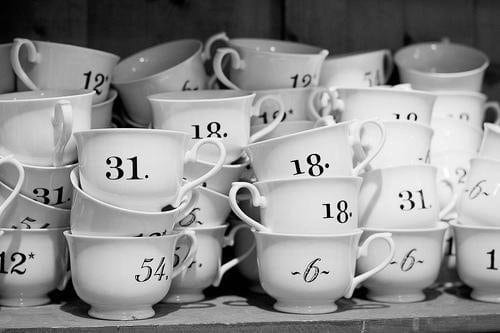
How Many Trades?
In most lines of business, time is the main driver for evaluating performance. Companies report on a quarterly basis to the street, which fundamental analysts then feverishly work through the data to assess a company’s future growth potential.
Well, how long should you wait to evaluate your trading performance…yearly, monthly, daily?
The answer to this question is very simple. Base your evaluation period on the number of trades placed and not by the amount of time passed.
Time is irrelevant in the world of trading. Trading is one of the few areas in this realm, where the space-time continuum are of no relevance.
Those of us that have been trading for some time know that one-year’s stellar trading performance can lead to a 2-month binge of destruction, which can easily eradicate everything you’ve worked so hard to create.
The way to address the tracking of your performance is to create a set number of trades that you will evaluate against key performance metrics, which we will touch upon next.
You will need to identify the right number of trades for you to evaluate, but this number needs to be high enough that you have a decent sample set, but low enough where it prevents you from going on a destructive trading binge.
For me, that number is 10 trades. This applies to both my swing trading and day trading activities. On average, it will take me approximately 3 months to place 10 swing trades and about 4 days to place 10-day trades. I only mention the time element so you can see how long it takes me to place that number of trades based on my trading style, but you can easily perform the same math in your head.
So, what is the number of trades you will use when evaluating your trading activity?
#2: Identify Your Key Performance Metrics
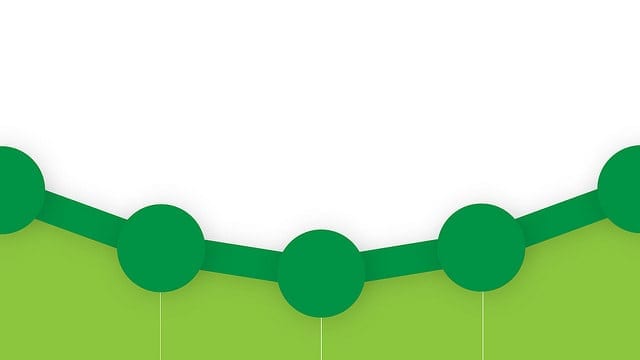
Performance Metrics
I use the KISS method or Keep It Simple, Stupid (for those new to the term) for measuring my trading performance. To that aim, I only care about the following two metrics:
- R
This is a ratio of your profitable trades divided by your losing trades. Over a 10 trade cycle, I would take, for example, $15,000 (winners)/$5,000 (losers), which would equal an R of 3. This essentially translates to the fact I profit three times more than I lose. You will want to measure R over every cycle. There is no set minimum or maximum R value; however, you will want to track your performance over time and quickly identify when you are below your historical average.
- Maximum Drawdown
- This is the lowest intraday dollar value of your account within a trading cycle. Most max drawdowns require a new high to take place in order to mark the drawdown. I, however, feel this is not the right approach, because it could take you a series of trading cycles before you hit a new portfolio high. I recommend that you determine how low your account has gone from the starting point of the cycle in percentage terms. For example, if I have a starting portfolio value of $100k for a 10-sprint cycle and my account value hits $80k, then my max drawdown was 20%. Just like R, there is no hard and fast rule on maximum drawdown. Over time, you should aim to reduce your drawdowns, as this will ultimately lead to a portfolio balance that continues pointing up and to the left, with very little pullbacks.
#3: What Time of Day will You Trade?

Time
For my day traders, I highly recommend you limit your trading activity.
For me, I trade from 9:50 am – 12:00 pm. Any trade activity occurring before or after this zone, I am purely a spectator on the sideline.
#4: Define Your Trading Edge
Similar to the times of day you will trade; keep your trading edge down to one or two setups when starting out. The more strategies you hope to master, the more difficult it will become to consistently make money in the market.
Below are the details of my trading edge:
- Early Range Breakouts
- High Volume
- Tight Spreads
- Consolidation prior to the breakout
- Only enter new positions between 9:50 am and 10:10 am
That’s it. If you feel your list bubbling up to 20+ criteria, you will drive yourself crazy trying to respect all of your rules
#5: Identify Stocks to Trade
Develop a standard methodology for identifying plays. You will have to first ask yourself the question, what is my time horizon for this trade? Day traders will want to focus on stocks in the news, while long-term traders will want to focus on stocks that are developing new business models that show the potential for multi-year growth. Whatever your trading style, make sure you identify the plays that have the highest odds of profitability.
For day traders, you will want to focus on the market movers. This provides you with the greatest opportunity for locating stocks that are trending hard with high liquidity. Within TradingSim, our market movers component provides you the top list of gainers and losers in real-time. This way you don’t have to navigate through hundreds of charts manually.
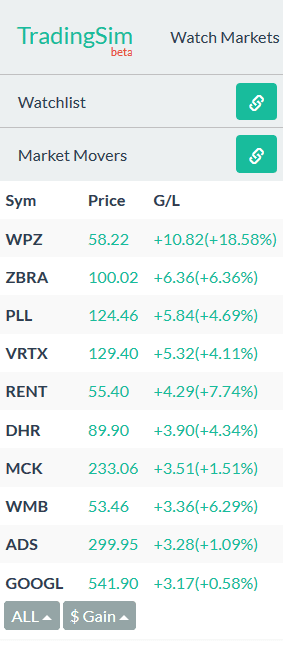
TradingSim – Market Movers
Once you have found a stock you like, you will need to add the stock to your watchlist, so you can keep an eye on the security.
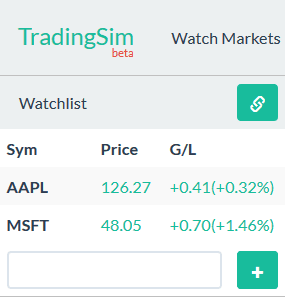
TradingSim – Watchlist
#6: Place Your Stop Loss

Stop losses are not a negative thing; they are what keep you in business over the long haul
My stop loss is once the position goes against me by 2%. The 2% threshold is based on the volatility of the stocks I trade and may not be suitable for your trading style. The point here is just to make sure you have a stop loss. If you find your stop is consistently being hit, then you need to take a deeper look into the volatility of the stocks you are trading.
#7: When to Exit
You have heard all the market wizards say, “Let your winners run”. Well, once you figure out what that means please let me know.
The greed in you will prevent you from closing your winning trades, even after you hear that little voice in your head tell you the run has come to an end. The way to avoid this scenario is to have a clear exit strategy.
Again, keep it simple. The exit strategy should be as simple as when the stock crosses below a moving average or the VWAP.
If you would like more insight into my own exit strategy for swing trading please take a look at the article I wrote titled ‘How to Let Your Winners Run – 7 Tips for Success’.
#8: How Much Money Can I Use per Trade?
Without money management, you will not stand a chance of making it in the business of trading. For me, the amount of money I can use per trade largely depends on how well I am performing. If I am going through a rough patch and my key performance indicators are down, then I use less money to minimize the damage to my account balance.
However, for keeping it simple in this article, I only use 10% of my available day trading buying power per trade. For example, if I have $250,000 cash, this would translate to $1,000,000 in day trading buying power; hence, I would use $100,000 per trade.
#9: When to Take Breaks

Take a Break from Trading+
This is something you will not see in other trading plans on the web. When will you take a break from trading? Sounds like a no-brainer, but you will be surprised how many traders I talk to that never take breaks. Whether the trader has just had the best series of trades or an all-out massacre of their account, the vast majority of traders just keep placing trades, day after day.
I take a break after I have placed 100 trades. I will take a day off just to give myself time to relax and reflect on my trading activity. You could be asking yourself; couldn’t I just take a break on the weekend or over federal holidays? Very true, but taking a self-imposed break goes back to discipline and exercising my control of the market. While the market is always there, I don’t always have to respond to her every move.
#10: Limit Up/Limit Down
The major exchanges and prop firms think in terms of limit up and limit down. This concept of curbs in was originally created after the 1987 crash and like everything else has become so complicated, it’s not worth trying to explain in less than 5,000 words.
For prop firms, their risk management rules will closely monitor how much a trader is up or down for the day. Once a trader reaches a particular extreme based on their past trading performance, this trader is not allowed to place any additional trades for the day.
Why do we as traders not think in terms of limit up or limit down?
For me, if I lose 2% of my trading capital at any point of the day, I need to exit all positions and go fishing. Conversely, if I make 7.5% of my trading portfolio in one day, it is time to go fishing.
Have you ever thought in terms of limit up/limit down? What are your limit up/limit down targets?
Sample Trading Plan
Now that we have covered the 10 inputs of a trading plan, below is a sample trading plan for your review. While this is a sample trading plan for day trading, you can simply change the parameters and apply them to any trading period for success.
| Al’s Day Trading Plan |
| How many trades will I use to measure my performance? 10 |
| What time of day can I enter new positions? 9:50 am – 10:20 am |
| At what time of day must I close all open positions? 12:00 pm |
| How much will I risk per trade? 2% of the position |
| How much money will I use per trade? 10% of day trading buyer power |
| How will I find stocks to trade? I will use a market scanner to identify top gainers and losers for the day. |
| When will I exit a winning position? When the stock crosses below the 10-period SMA on a 5-minute P&F chart |
| What is my trading edge (do not get too crazy on this response. Keep your answer short to avoid overthinking it)?
- Early Range Breakouts
- High Volume
- Tight Spreads
- Consolidation Prior to the breakout
|
| How will I measure my performance: R, Maximum Drawdown |
| How many trades will I place before I take a break? 100 |
| How long is my break? 1 trading day |
| What is my limit up percentage? 7.5% of my account value |
| What is my limit down percentage? 2% of my account value |
Credit
Beach Photo by Trish Hartmann
Time Photo by Sean MacEntee
Performance Metrics by Alan O’Rourke
Tea Cups by Clyde Robinson

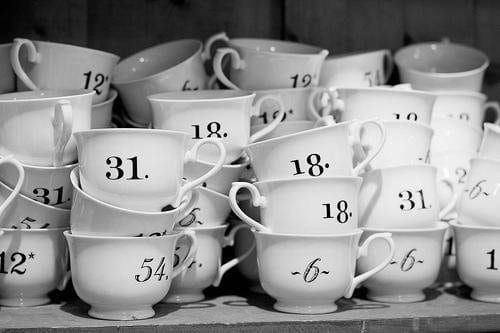












 Day Trading Performance
Day Trading Performance 
